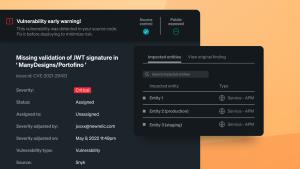At iCIMS, the talent cloud company that empowers employers to attract, engage, hire, and advance the world’s best talent, user experience is everything. Since 2000, iCIMS has been solely dedicated to getting recruitment right, which means a laser focus on the experience of its users: hiring managers, job candidates, recruiters, and others. Experience is built into every product decision, every user interaction, and the company culture itself.
We recently spoke with Ben Barresi, director of cloud hosting at iCIMS and James Kim, manager of cloud operations at iCIMS to get more insight into the unique ways the company uses New Relic to deliver on its experience promise.

New Relic: Congratulations on being an award-winning talent cloud company and becoming #1 in the global recruitment technology market. What does this mean in terms of your customer base and applications processed?
Ben Barresi: Thanks! We are proud to serve a large customer base and impact the lives of millions – we have more than 4,000 global customers, including nearly 30% of the Fortune 100 companies, who employ more than 30 million people worldwide. Our platform processes more than 75 million job applications annually. By the way, New Relic Browser and Dashboards help us track these and other statistics to measure our reach around the world.
James Kim: We also have an extensive partner ecosystem and one of the largest marketplaces in our industry, as we work with more than 700 Talent Cloud partners, with 300+ productized integrations, rich APIs, and an Application Marketplace. Those integrations are instrumented with New Relic APM.
New Relic: Your company’s New Relic implementation is rather unique. Tell us how you’re using it differently to help you fulfill your company’s mission.
Ben: The number one priority for everyone at iCIMS is delivering the best customer experience. To deliver on this, we instrument literally everything, with New Relic powering our mission in many ways. The experience that a job seeker has on our platform reflects on our customer’s brand. We take that very seriously and do everything we can, with insight from New Relic, to make the experience easy, engaging, and positive to create a good impression of the employer, our customer.
 Ben Barresi,
Ben Barresi,James: The biggest difference in how we’re using New Relic to maintain our focus on the customer experience is that, unlike most companies, we instrument each customer as a separate, isolated application. We also instrument each unique view or journey for that customer so that there’s one app in New Relic for a customer’s candidate traffic, one app for a customer’s hiring managers, and so on. This gives us many ways to look at our customers individually.
That means that we have more than 20,000 individual apps that we monitor in New Relic at any one time. When a performance alert comes in, it’s tied to a certain customer and view. My entire team is dedicated to making sure we’re delivering the best experience for every customer.
New Relic: As a multi-year Stevie® Award winner for customer experience, what advice would you give other New Relic customers on which key performance indicators (KPIs) are most important to monitor and track?
James: When you have everything instrumented, there are many KPIs that you can track. And while we do have performance thresholds set up on many different metrics, there is one KPI that we consider to be our golden signal: Apdex.
Apdex is an industry standard designed for high-throughput apps for measuring user satisfaction, which fits really well with what we are trying to accomplish. We aim for .9 for each customer (on a scale of 0 (worst possible) to 1 (best possible score)).
New Relic: Do you relate Apdex back to business outcomes as well?
Ben: Because we’re selling experience, keeping our Apdex high helps us retain customers. Delivering on our experience promise also helps us achieve Stevie Awards, which in turn, drives new business and growth. We also use Apdex scores in pre-sales situations as proof of the scalability of our platform. When a large global company wants assurance that we can support a business of their size, we can show them performance of a similar or larger-sized customer on our platform.
New Relic: You’ve mentioned that iCIMS teams use trending New Relic data visualizations to identify areas for performance. Can you give us a bit more detail?
James: We began implementing a site reliability engineering (SRE) approach last year, which we’re also using to be more proactive. Instead of waiting for an issue to happen or an alert notification, we’re doing weekly analysis of all the New Relic data to pinpoint areas of slower performance. We then start our SRE process as if there were an incident and identify what needs to be done to fix problems proactively.
We’ve done a great deal of work with New Relic APIs to improve observability by collecting as much analytical data as possible about customer performance. That way we can identify areas such as a background screening task that took longer than normal to complete. Then we kick off our incident management process even though no one has complained about it yet.
New Relic: Speaking of incidents, can you give us some insight into what the incident management process looks like for iCIMS?
James: Our incident management process involves many different areas of our business, from the SRE team to cloud operations, customer support, engineering, and other groups. We have a defined chain of events, which includes using New Relic to determine whether it’s an infrastructure issue or a code-related problem. If it’s code-related, we have a whole team of developers on standby to help triage it. We then work very closely with the development teams to get any code problems ironed out.
New Relic: Looking back, how has the recruiting software industry changed and how does New Relic help you stay ahead of those changes?
Ben: The recruiting experience has evolved technologically in ways no one had imagined just 10 years ago. Back then, people didn’t apply for jobs on their mobile phones. They didn’t text with recruiters. Today we have virtual reality, artificial intelligence (AI), chatbots, video, and more that are becoming commonplace in the recruiting experience. All of these modern, virtual recruiting tools are especially critical in today’s environment where many people are working remotely or are in hybrid and constantly evolving workplace environments.
James: In addition to New Relic giving us insight into the experience with any new capabilities we introduce within our mobile app and our platform, it also helps us seamlessly integrate new technology stacks into our environment. In the past two years, we made two major acquisitions that introduced brand new technology stacks. Neither of these companies had a mature monitoring capability, so with help from New Relic, we learned how to instrument the new stacks as we integrated them into our environment to deliver the same customer experience and value.
New Relic: Any final advice for other New Relic customers on how to deliver the best customer experience?
James: If you can gear your entire technical operations toward the commitment to customer experience, that’s the foundation for everything else. Then, depending on the maturity of your operations, instrument everything you can, down to the individual customer level. Of course, depending on your industry, make sure to follow best practices around data privacy, such as obfuscating data collected in New Relic.
New Relic: Ben and James, thank you for sharing your experiences with us. Readers, be sure to watch Ben discuss iCIMS’ experience using New Relic in the video below.
[embed]https://www.youtube.com/watch?v=xlG-NlhGeoQ&t=1s[/embed]
The views expressed on this blog are those of the author and do not necessarily reflect the views of New Relic. Any solutions offered by the author are environment-specific and not part of the commercial solutions or support offered by New Relic. Please join us exclusively at the Explorers Hub (discuss.newrelic.com) for questions and support related to this blog post. This blog may contain links to content on third-party sites. By providing such links, New Relic does not adopt, guarantee, approve or endorse the information, views or products available on such sites.



